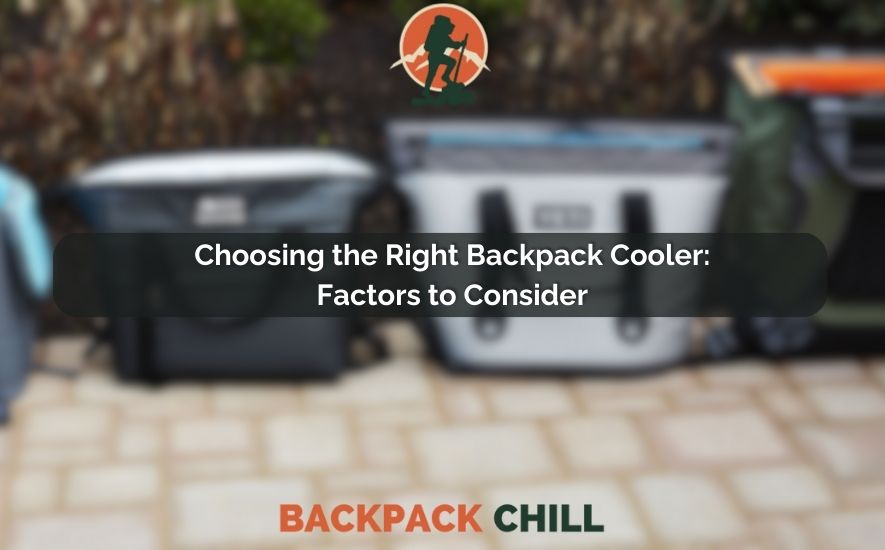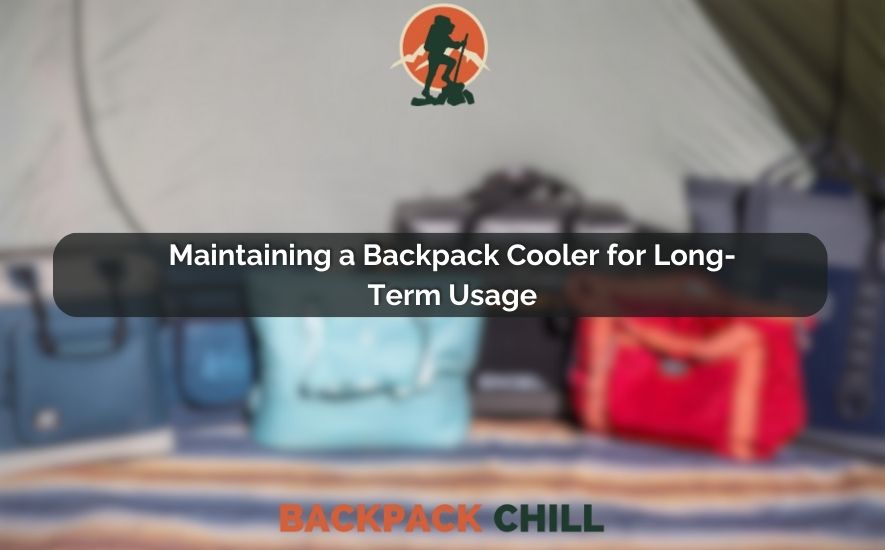Physical Address
304 North Cardinal St.
Dorchester Center, MA 02124
Physical Address
304 North Cardinal St.
Dorchester Center, MA 02124

When it comes to leisurely outdoor adventures, whether it’s a relaxing day at the beach, a serene hiking trip, or a fun-filled picnic in the park, keeping food and drinks cool becomes a pivotal aspect of ensuring a delightful experience. Enter the backpack cooler – a nifty invention designed to seamlessly merge the convenience of a backpack with the functionality of a cooler. The concept might intrigue you, but the question lingers: Are backpack coolers truly worth the investment?
Are Backpack Coolers Worth It? Backpack coolers can indeed be worth it for many outdoor enthusiasts. These compact, hands-free coolers offer a convenient way to keep your food and beverages chilled on the go, ensuring you stay refreshed during your adventures.
Today, In this article, we’ll delve into the realm of portable coolers, weighing the pros and cons, exploring their versatility, and considering the practicality they bring to our outings.
One of the primary advantages of backpack coolers is their portability. Unlike traditional coolers that require dragging or carrying with both hands, backpack coolers can be effortlessly carried on your back.
This feature is especially beneficial for hikers, campers, and beachgoers who need their hands free for other activities like climbing, trekking, or playing beach sports. With adjustable straps and ergonomic designs, these coolers ensure maximum comfort during extended periods of wear, making outdoor adventures much more enjoyable.
Backpack coolers are engineered with advanced insulation materials that maintain the internal temperature for extended periods.
This insulation ensures that food and beverages stay cool for hours, even in hot and humid conditions. For hikers and picnickers who venture far from their base, a backpack cooler ensures they have refreshing drinks and chilled snacks readily available throughout their journey.
These coolers are ingeniously designed to optimize space and provide multiple compartments for storage. Alongside the insulated main compartment for food and drinks, many backpack coolers include additional pockets and slots for carrying utensils, napkins, and other essential items.
This thoughtful organization prevents the need for carrying multiple bags, enhancing the overall outdoor experience by keeping everything conveniently accessible.
The best backpack coolers are crafted from eco-friendly and durable materials, reducing their environmental impact and ensuring long-lasting performance. These materials are often waterproof or water-resistant, protecting the contents from accidental spills or unexpected rain showers.
Their durability also makes them ideal for rugged outdoor activities, where equipment is exposed to rough conditions and handling.
Backpack coolers are versatile companions, suitable for a wide range of activities. Whether you’re heading for a day at the beach, going on a fishing trip, or attending a music festival, these coolers adapt seamlessly to various scenarios. They are also a hit among sports enthusiasts, as they can keep hydration close at hand during intense workouts or team practices.

One of the first factors to consider when choosing a backpack cooler is its size and capacity. Consider how much food and drink you typically need to carry and for how many people.
Smaller coolers are suitable for solo outings or short trips, while larger ones can accommodate a group’s needs. Keep in mind that a larger capacity may mean more weight to carry, so strike a balance between the two based on your specific requirements.
The primary purpose of a backpack cooler is to keep your items cold for an extended period. Assess the insulation performance of the cooler before making a decision.
Look for high-quality insulation materials, such as thick foam or multiple layers of insulation, to ensure maximum cooling efficiency. Additionally, check for features like leak-proof lining and airtight zippers to maintain the internal temperature and prevent any accidental spills.
Since you’ll be carrying the backpack cooler for extended periods, comfort and mobility are crucial aspects to consider. Opt for a model with padded shoulder straps and a breathable back panel to distribute weight evenly and reduce strain on your shoulders and back.
Adjustable straps are also beneficial, allowing you to customize the fit to suit your body shape. Additionally, a chest strap and waist belt can provide extra stability and make carrying the cooler more comfortable during long hikes.
Outdoor activities can expose your backpack cooler to rough conditions, so choosing a durable and robust model is vital. Look for materials like high-quality nylon or polyester that are water-resistant and can withstand wear and tear.
Reinforced stitching and sturdy zippers contribute to the overall durability of the cooler. Investing in a well-built backpack cooler will ensure it lasts for years, even with frequent use in various outdoor environments.
To enhance your overall experience, consider any additional features or functionalities offered by the backpack cooler. Some coolers come with external pockets for easy access to essentials like utensils or napkins. Others may have side mesh pockets for holding water bottles or small accessories.
Built-in bottle openers, detachable pouches, or adjustable dividers are other features worth exploring. While these extras are not essential, they can add convenience and make your outdoor adventures more enjoyable.

Regular cleaning is fundamental to keeping your backpack cooler in pristine condition. After each use, make sure to empty and wipe down the interior with a mild soap and warm water solution. Thoroughly rinse to remove any soap residue.
Additionally, sanitize the cooler with a mixture of water and vinegar or use a food-safe disinfectant. Avoid harsh chemicals that might damage the material or leave unwanted odors. Always allow your backpack cooler to air dry completely before storing it to prevent mold and mildew growth.
The insulation plays a crucial role in keeping your items cold, so it’s essential to maintain its effectiveness. Before each outing, pre-cool the cooler by adding a few ice packs or ice cubes for a few minutes. This step helps to maximize the cooling efficiency during your trip.
Avoid exposing your backpack cooler to direct sunlight for extended periods, as it can degrade the insulation’s effectiveness over time. If you notice any signs of damage to the insulation, such as leaks or reduced cooling performance, consider replacing the cooler to ensure your items stay adequately chilled.
The zippers and seams of your backpack cooler are potential weak points where heat can enter or cool air can escape. Inspect these areas regularly for any signs of wear, damage, or debris. If you notice a loose or damaged zipper, repair or replace it promptly.
To maintain the waterproofing capabilities of the seams, avoid submerging the cooler in water for extended periods and refrain from overloading it, as excessive strain on the seams may lead to leaks.
Unpleasant odors can quickly develop inside a backpack cooler, compromising the taste of your food and drinks. To keep your cooler smelling fresh, avoid storing it with food residues or spills.
After each use, thoroughly clean the interior and leave it open to air out. You can also place a box of baking soda inside the cooler when it’s not in use to help absorb any lingering odors. Remember to replace the baking soda every few weeks for optimal results.
How you store your backpack cooler when it’s not in use significantly impacts its longevity. Always store the cooler in a cool, dry place away from direct sunlight and extreme temperatures.
Avoid leaving it in the trunk of a hot car for extended periods, as high temperatures can damage the insulation and affect its cooling performance. When not in use for an extended period, store the backpack cooler with the lid slightly open to allow for proper ventilation and prevent the growth of mold and mildew.
In conclusion, after thoroughly examining the pros and cons of backpack coolers, it is evident that these nifty companions are indeed worth the investment. Beyond their undeniable practicality for outdoor enthusiasts and adventurers, they provide a stylish and trendy edge to any outing. The convenience of hands-free portability and easy access to chilled refreshments sets them apart from traditional coolers.
Despite their slightly higher cost compared to conventional options, the added benefits they offer in terms of comfort and versatility make them a valuable addition to any traveler’s gear collection. So, whether you’re picnicking, hiking, or simply strolling along the beach, a backpack cooler is sure to keep you and your drinks cool in style!
Absolutely! Converting a regular backpack into a cooler is simple. Just insert an insulated cooler bag or an appropriate cooler insert into the backpack. These inserts are designed to maintain cold temperatures and prevent leaks.
Fill the insert with ice packs or gel packs to keep your items chilled. Now, you have a portable backpack cooler, perfect for carrying refreshments on the go!
A backpack cooler is versatile, accommodating various items. Pack your favorite drinks like water bottles, juice boxes, and soda cans for hydration. Include snacks like sandwiches, fruit, granola bars, nuts, and crackers to maintain energy and avoid food stall lines.
Remember ice packs or gel packs to keep everything cool. Additionally, it can store medications, baby essentials, and perishable items purchased during your day out.
The Yeti M20, renowned for superior insulation, keeps ice for an extended period. Depending on factors like temperature, cooler usage, and ice quality, it can retain ice for about 4 to 5 days on average.
Optimal conditions and additional ice packs or dry ice might even extend this to 7 days or more. Pre-chill the cooler, use block ice or ice packs, and minimize opening to maximize ice retention.